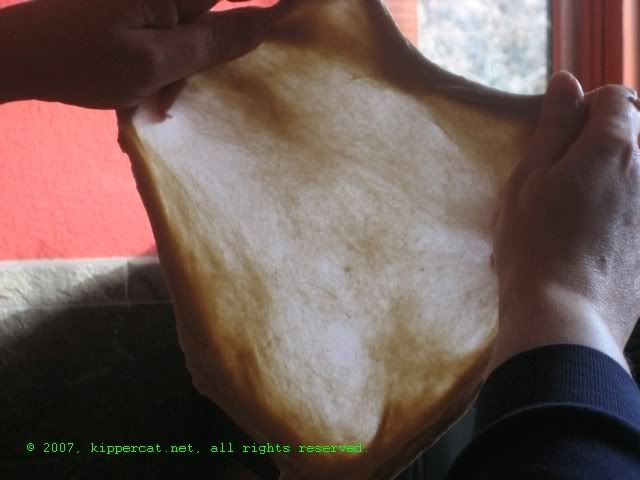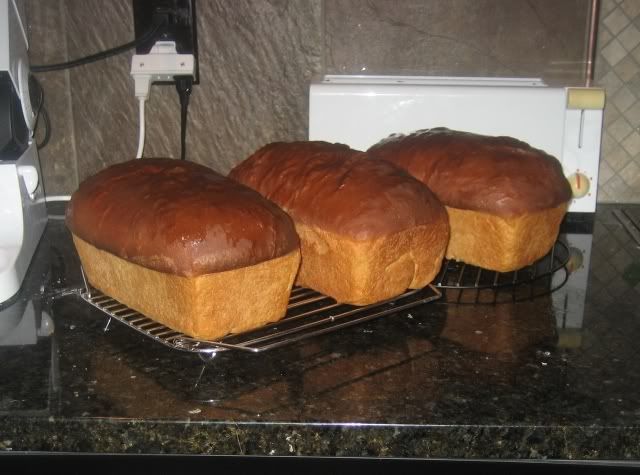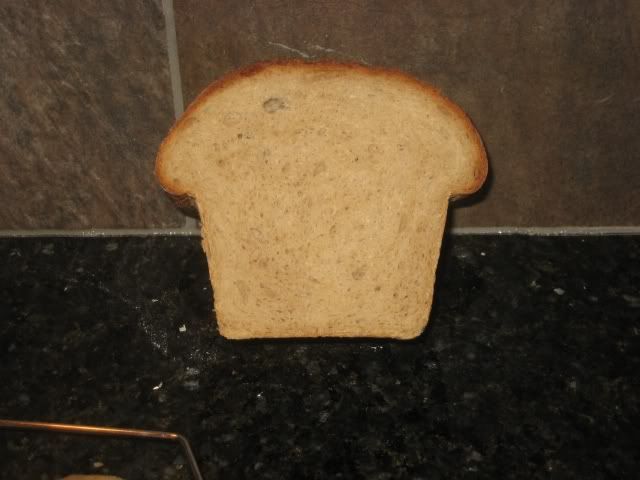This picture is from a 100% whole wheat, rather high hydration dough. It had been kneaded for about 20 minutes at speed 2 in a Delonghi/Kenwood mixer. The lighting isn't that great, but if you look at the base of the left thumb, you'll see a fingertip behind the dough. The browner areas are simply dough that has not been stretched. This started as a piece of dough about the size of a golf ball And yes, it made nice bread - in this case a light sandwich loaf.



Wow! That is a beautiful loaf of bread! The crust looks perfect! I am guessing by your use of the "window pane test" that you are using one of Peter's recipes?
Great job!
TableBread
David
ahhh beautiful.
can this result be achieved with the no knead technique
again beautiful.And I will be the first to admit that I haven't gotten a windowpane that looks like that with whole grains.
I have been reluctant to do long kneadings after reading comments about oxidation of the flour. In fact, I fold exclusively now (usually 3-4 over the rising time) which develops lovely gluten without the risk of oxidation. Parousia-I haven't tried much whole grain hearth bread recently, but I bet you could do that with turns.
was this mass produced/store bought
or fresh ground, also what type of wheat was used, if you know.
thanks,
p
Wow, you guys make me blush! Thank you for your lovely comments.
I didn't knead well enough for a long time either. I suspect that I'll conclude that folding is better for most breads, but my husband really wanted a nice soft sandwich loaf, and I knew that I could get the closest with machine kneading. (That's not to say that someone else couldn't do it with folding, I'm just too inexperienced with the method.) He's suffered through many attempts, but with this one he tells me I DID IT!! The flour is roughly 2/3 King Arthur whole white wheat, and 1/3 Bob’s Red Mill whole (red) wheat. My husband took the picture. It did take a few attempts to get the light to show through. The recipe is more or less the roll recipe in my blog. BUT I was adding water while talking to my husband, and added way too much. So I tried to increase all of the other ingredients proportionately. I ended up with three good-sized loaves and 5 hamburger buns. It’s not one of Peter’s recipes, but it does use the method from his new whole grain book. In many ways, it's closer to Aunt Agatha's dinner rolls in the Laurel's Kitchen bread book. Here are the notes and quantities from my Bread Journal, -BUT- THE blogged recipe IS PROBABLY EASIER TO MAKE. Eventually I'll scale it right so that it makes 3 loaves, with no leftover rolls or whatever.
------------------------------------------------------------------------------------------------
12/17/07 – WW Sandwich Loaf
Based on Thanksgiving rolls, that Browndog made such a nice loaf out of. I mismeasured water while setting up the biga, so had to increase the quantity of dough. This was a lot of dough for my machine (stand mixer) – especially at the point where I tried to combine the soaker and biga without any additions. It was too stiff. I’m not sure how necessary the extra water would have been if the dough were combined in a different order – especially as I then added 35 grams flour to the final dough, and still had a soft dough. Perhaps add an extra 30 grams water to the soaker to begin with?. At mixing time, I might try combining the final dough elements with only part of the preferments, then adding the rest of pre-doughs to bowl.
~ Soaker ~20 grams potato flakes
480 grams finely ground white WW flour
¼ cup (45 grams) buttermilk powder
1 tsp. Salt
352 grams water
~ Biga ~
820 grams finely ground white WW flour
609 grams water
½ tsp. Instant yeast
~ Final Dough ~All of soaker
All of biga
3 ½ tsp instant yeast
4 tablespoons honey
60 grams water (unplanned)
35 grams white flour
2 eggs
2 ½ tsp salt
6 Tablespoons soft unsalted butter – ¾ stick
Mixing instructions are basically the same as the dinner roll recipe in my blog.
Am interested if you used the cold oven / no preheat baking method or just went with a preheated oven.
I too missed this post (too close to the holidays I guess). However, I gave your post an "excellent" rating as my way of saying thanks.
The photo of the windowpane test is really excellent.
To my surprise, there's nothing in my notes about how this loaf was baked. But browndog has baked this loaf many times with a cold start. You can see a picture of her bread in my blog entry for whole wheat dinner rolls. Here's what she said
"I baked it cold-start, set the oven at 400*, left it for 10 minutes then reduced the heat to 350* for another 45 minutes."
As hard as I worked to come up with this formula, I haven't baked it since. Life got kind of crazy and I've limited myself to simple no-knead breads. Funny when I expected to bake this once a week!
Full credit given, of course. Thanks again for taking the time to post it.
More on Cold Oven Baking...
Alas, what I seek is feedback whether cold start baking works for freeform loaves baked on a flat surface. This has never worked for me (little oven spring, dense loaves). In contrast, any bread baked in a container - loaf pan or baking dish for rolls - does well with a cold start.
Thank you! I'll have to go take a look.
As for freeform coldstart, the best results I've had have been in a dutch oven. But I'm not sure it comes out as well as on a preheated stone. I haven't done exact comparisons.
[quote=kippercat on March 27, 2008]As for freeform coldstart, the best results I've had have been in a dutch oven.[/quote]
I don't consider dough baked in a dutch oven to be "freeform". The sides of the dutch oven support the dough during baking so even a high hydration dough must rise up rather than spreading out (using the lid during baking results in the "oven within an oven" approach to baking, so that the steam given off during the beginning of the bake doesn't dissipate).
To me, freeform means a loaf baked on a flat surface - nothing to support the sides of the dough during that crucial oven spring stage.
I made some WW miche style bread with canadian red spring wheat last night.
All soaker + starter...no additional flour or water.
I got windowpane without much kneading required.
Sadly the bread didn't hold up enough and baked fairly flat. For whatever reason my dough just wouldn't hold (70% hydration). I'm starting to think there's an issue with the starter I'm using. The results were VERY sour (tickle the back of your throat type sour)...TOO sour for my liking.
I think the dough is basically falling apart during proofing due to gluten being destroyed which is strange since the proof times were moderate (7 1/2 bulk ferment, 3 1/2 final)
To much protease action perhaps? I seem to find this problem with WW and white flour sourdoughs alike. I posted about this a few weeks ago and the problem was solved, albeit temporarily, by changing the ratio of starter to flour/water etc. but although I kept the same ratio of starter/build to final dough in my subsequent attempts, any other changes I made (eg switching to WW flour, altering hydration etc.) resulted in everything tending towards mush again.
Vinegar pancakes anyone? :)
Help needed / appreciated...I feel I need to get a handle on the underlying principles re: sourdough & gluten, sourdough & acid production
I'm always nervous offering advice about sourdough, as my results vary so widely from great to gag, but I do know that things got a lot better after I went back and re-read Hamelman's Bread (and baked a bunch of stuff from it). By most standards, he has a very short final proof for his sourdoughs, and once I switched to his method, I was much happier.
I'm not big on really sour bread, so I'm not worried about losing out on flavor with a short proof, so this works for me. I think 1 1/2 -2 hours is more what he does for final.
Keep at it!
edh
I think you may be on to something there...I'll give it a go. Thanks
FP